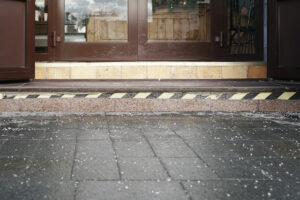Protecting Your Concrete from the Harsh Winter Weather

While concrete is a strong and durable material. the harsh winter weather can still cause damage.
Winter is rapidly approaching, and with that means plenty of snow, sleet, and hail. This means you should take the right steps to protect your property’s concrete surfaces, including walkways, patios and balconies, and other exposed outdoor surfaces. Concrete is porous, and that means that it absorbs water readily. Porous materials are more easily damaged during winter freeze-thaw cycles than non-porous ones. While concrete is a strong and durable material, it isn’t resistant to all chemicals and other treatments you might apply to keep it snow and ice-free. Read on to learn how you’re able to protect your concrete from the harsh winter weather!
Seal the Concrete Surfaces Regularly
An easy way you can protect concrete surfaces from winter freeze is by applying a sealer to them on a regular basis. There are two types of leading concrete sealers: film-forming acrylic sealers and penetrating sealers. Acrylic sealers dry to form a weather-resistant film on top of a concrete surface that will protect it from water penetration and some deicing chemicals you might use during the winter. On the other hand, a penetrating sealer will not create a film on the concrete surface but instead will penetrate deep down into the concrete pores to coat the interior with a water-replant substance. These sealers should be applied shortly before or after winter arrives. If you wish to avoid the use of sealers altogether, consider hiring G&M Services for concrete repair. This will help you avoid any cracks or fissures, and will prevent existing cracks from getting any worse during the winter!
Limit the Use of Chemical Deicers
Limit the use of any chemical deicers during the winter and pick them wisely. A few deicing chemicals can harm concrete sealers and the concrete surfaces under them right away, while others can gradually harm the surfaces over time. Avoid using deicers that contain any ammonium nitrate or ammonium sulfate too. These can harm concrete by causing it to slowly disintegrate. Ideally, you should cover any slippery concrete with ordinary sand. Sand won’t melt the ice, but it does create traction on the ice surface and makes it less slippery and a bit safer to walk on.
Remove Snow off Concrete Regularly
After a heavy snowstorm, you might be tempted to leave a little bit of snow on your driveway after you remove just enough to drive your car in and out of it. However, you should remove all the snow from outdoor concrete after each snowfall. If you don’t remove the snow when temperatures are still below freezing, it could melt when temperatures rise, seep into the concrete’s pores and cracks, then freeze back into ice. When water freezes in these openings, it will expand and place pressure on the concrete causing it to crack. A small amount of effort today can save a ton of money avoiding costly concrete repairs!
Revitalize Your Business with G&M Services
G&M Services is proud of our employees and the dedication they have for safety in the workplace. We reward our employees for displaying positive safety practices. We incorporate weekly and monthly discussions and meetings to ensure that all involved know how to handle equipment and potentially risky situations during a project. We offer services in the way of concrete drilling and sawing, concrete scanning, and Firestop. To get started with us, call today at 410-787-8828 or visit our contact page. Follow the official company page today on Facebook, Twitter, and LinkedIn.








